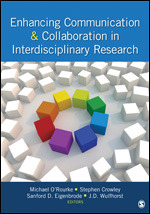Enhancing Communication & Collaboration in Interdisciplinary Research
- Michael O'Rourke - Michigan State University, USA
- Stephen Crowley - Boise State University, USA
- Sanford D. Eigenbrode - University of Idaho, USA
- J. D. Wulfhorst - University of Idaho, USA
Explore the many facets of interdisciplinary communication and collaboration
"This book integrates a number of issues within interdisciplinary studies in new and interesting ways. It makes highly theoretical material accessible with an engaging style that is scholarly without being stuffy. The author is clearly well versed in science, philosophy, and higher education and achieves a balance across that learning. One of its great strengths is its explanations of very complex theoretical issues in language that it is possible for a well-educated person to understand without a disciplinary background in philosophy.”
“The breadth is one of its strengths. There are a large number of approaches that include analysis of quantitative data, very detailed case studies, philosophical analysis, perspectives of administration and organization of universities, and collaborations between researchers and community members outside academia, just to name a few. These varied approaches force readers to think beyond the perhaps narrow aspects of interdisciplinary communication that affect their own research or teaching or programs. That is a welcome challenge.”
“The text is extensively researched and well organized. The author/authors have also managed to bring in historical elements in higher education, as well as current thinking in the field.”
Too high level for my students


